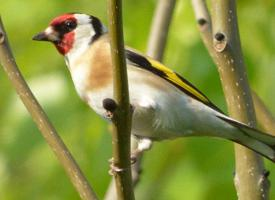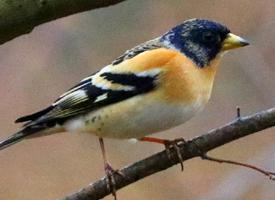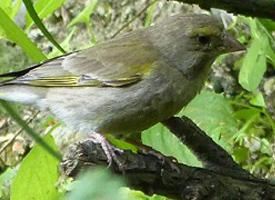
Poids et mesures
| Longueur | 12 cm |
|---|---|
| Poids | 16 g |
| Envergure des ailes | 23 cm |
Description de l'animal
The European goldfinch, scientifically known as Carduelis carduelis, is a small, yet strikingly colorful bird, belonging to the finch family. This bird is highly recognizable by its vibrant plumage and melodious song, making it a favorite among birdwatchers and nature enthusiasts alike.Measuring between 12 to 13.5 cm in length, with a wingspan ranging from 21 to 25.5 cm, the European goldfinch is a relatively small bird. Despite its size, it is hard to miss due to its distinctive appearance. The adult has a bright red face surrounded by white, with a black crown and nape. The back and flanks are a warm brown, while the belly and underparts are white. The wings are striking, with a broad yellow band, black primary feathers, and white spots visible when the wings are closed. The tail is black with white spots on the tips of the tail feathers. Both sexes exhibit similar plumage, though males can be slightly more vibrant.
European goldfinches are known for their beautiful song, a pleasant melody of trills and twitters, which they can often be heard singing from a high perch. They have a varied diet that primarily consists of seeds, particularly favoring those of thistles and teasels. This dietary preference has earned them a place in art and literature, symbolizing persistence and endurance. In addition to seeds, they also feed on small insects and invertebrates, especially during the breeding season to provide protein to their young.
These birds are quite social and can often be seen in flocks, especially outside of the breeding season. During breeding season, which typically runs from late March to early August, the European goldfinch adopts a more solitary lifestyle. Nests are carefully constructed by the female, made of moss, grass, and lichen, and lined with wool and feathers. These nests are usually situated in the branches of trees or bushes. The female lays between 4 to 6 eggs, which she incubates for around 11 to 13 days. The chicks are then fed by both parents and fledge approximately 13 to 18 days after hatching.
The European goldfinch has a wide range across Europe, North Africa, and western and central Asia. It inhabits open, partially wooded lowlands, gardens, orchards, and parks. The species is adaptable, often visiting bird feeders in gardens, which has helped to bolster its numbers in areas where suitable habitats are available.
Despite facing threats from habitat loss and degradation, the European goldfinch has maintained a stable population in many parts of its range, thanks in part to its adaptability and the popularity of bird feeding. It is classified as of Least Concern by the International Union for Conservation of Nature (IUCN), indicating that it currently faces no immediate threat of extinction.
In conclusion, the European goldfinch, with its vivid plumage, delightful song, and presence in cultural symbolism, is a cherished sight in its natural habitat. Its ability to thrive in diverse environments speaks to the resilience and adaptability of this enchanting species.
Carte de répartition

Animaux similaires
Nouvelles photos d'animaux
Top 10 des animaux
- Dolphin gull (Leucophaeus scoresbii)
- Diana monkey (Cercopithecus diana)
- Moustached guenon (Cercopithecus cephus)
- Galápagos tortoise (Geochelone nigra complex)
- Japanese macaque (Macaca fuscata)
- Stone loach (Barbatula barbatula)
- Russian tortoise (Testudo horsfieldii)
- Greek tortoise (Testudo graeca)
- Common flying dragon (Draco volans)
- Vendace (Coregonus albula)


